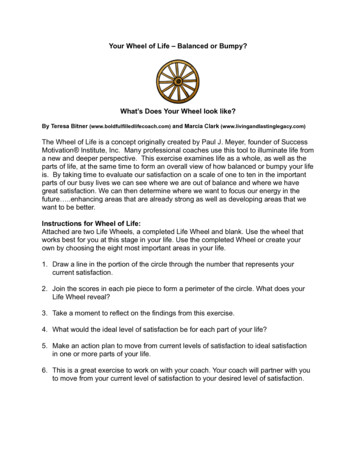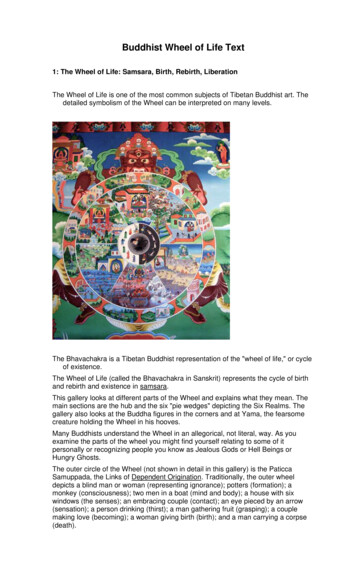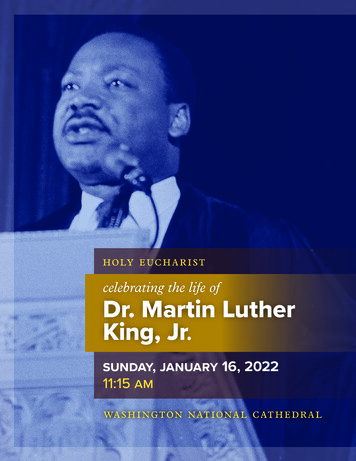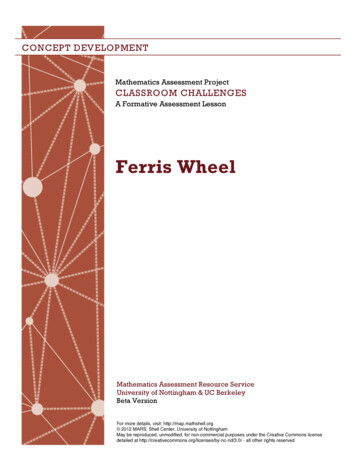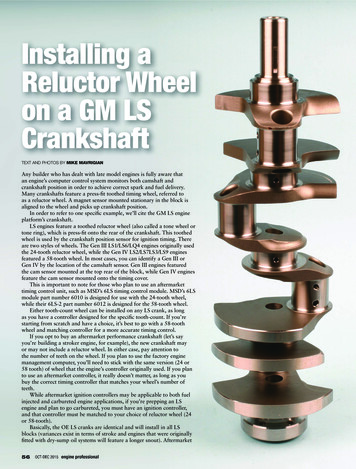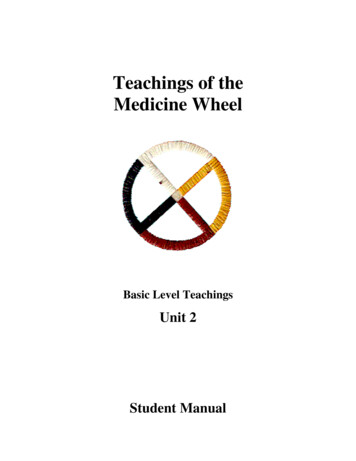
Transcription
Teachings of theMedicine WheelBasic Level TeachingsUnit 2Student ManualMEDICINE WHEEL – Student Manual1
Table of ContentsTeachings of the Medicine WheelPageOverview . 3Unit DescriptionLesson TimelinesUnit ExpectationsLesson 1: Introduction to the Medicine Wheel 4Lesson 2: Gifts of the East . . 13Lesson 3: Gifts of the South 21Lesson 4: Gifts of the West . 29Lesson 5: Gifts of the North 37Lesson 6: Culminating Activity .45Chart of Gifts . .49Word List .50References . . . .51Recommended Alternate Reading Resources .52MEDICINE WHEEL – Student Manual Ontario Native Literacy Coalition [2010]2
OverviewUnit DescriptionThe Medicine Wheel is a circular symbol representing the wholeness of traditional Native life. Itis a perfectly balanced shape without a top or bottom, length or width. It represents constantmovement and change. It also represents and symbolizes unity, peace, harmony and courage. It isa testimony of the human being’s ability to survive and to maintain balance. The ultimate goal isto strike a harmonious balance in life. The circular form of the Medicine Wheel shows therelationship of all things in a unity, a perfect form, and suggests the cyclical nature of allrelationships and interactions. Everything in the universe is part of a single whole.Lesson TimelinesLesson #TitleTimeLesson 1Introduction to the Medicine Wheel140 minutesLesson 2Gifts of the East140 minutesLesson 3Gifts of the South140 minutesLesson 4Gifts of the West140 minutesLesson 5Gifts of the North140 minutesLesson 6Culminating Activity200 minutesUnit ExpectationsOn the surface of the Earth, all is given from the Four Sacred Directions which are East, South,West and North. Each direction contributes a vital part to the wholeness of the Earth. Eachbrings physical powers as well as spiritual powers, as do all things. The focus of this unit is tohelp you become familiar with the Medicine Wheel and Four Directions. This will introduce youto how the Medicine Wheel functions as a teaching/learning tool.You will:be able to explore aspects of the Medicine Wheel such as the four directions, four aspectsof human nature, four traditional medicines, and the four elements through discussionsand recommended readings.explore opportunities for using the Medicine Wheel model in other aspects of your life.be able to transfer this model into other subjects such as mathematics, science and healthdemonstrate the perception and knowledge you gained from this unit.MEDICINE WHEEL – Student Manual3
Lesson 1Introduction to the Medicine WheelThis unit begins by introducing the Medicine Wheel and the Four Directions On the surface ofthe Earth, all is given by the Four Sacred Directions: North, South, East and West. Each of thesedirections contributes a vital part to the wholeness of the Earth. Each has physical powers aswell as spiritual powers, as do all things.Lesson Expectations:You will:learn some of the teachings of the Medicine Wheel and the Four Directionsunderstand how these teachings relates to the history of our peoplecontinue to seek knowledge about your own heritageMaterials:your Student Manualwriting Tools: pens, pencils, eraser and rulera notebook for your Word List/Glossarya notebook for your Reflection Journal Entriesa computer with access to the interneta dictionaryACTIVITY 1: Word List ReviewPlease read the words for this lesson on your own or with help from the teacher oranother learner.Think about what each word means. If you don’t know some of the words you can useyour dictionary to find the meaning. Talk about them with the teacher or with one of theother learners.Write the words and definitions (what they mean) in your word notebook.Word List Options for Lesson ationanalyzeACTIVITY 2: Prior KnowledgeTake a look at the Chart on the Medicine Wheel teachings on the next page. You can dothis on your own or with help from the teacher or one of the other learners in your class.If you have any questions about what to do, please ask your teacher for helpMEDICINE WHEEL – Student Manual4
Prior Knowledge Activation ChartQuestions to think aboutSome things you can doWhat do you know about Medicine Wheelteachings?Do you have any connection or experienceswith Medicine Wheel teachings?Share what you know or have heard aboutMedicine Wheel teachings with the class.Ask any questions you have.Do you have any questions about this topicbefore you begin reading the legend?Do you have any personal experience withother kinds of teachings?Talk about your experiences when theteacher asks the group to participate.Do you think this legend is important to theAnishnawbek people? Why?Talk about this with your class and teacher.Go back and look at your word list. If there areany you are not sure about, this would be agood time to ask the teacher.You can ask any questions you have aboutthe words and try to help the others withones they don’t know.ACTIVITY 3: Read Text (Legend)Look at the Reading Chart below. It shows different ways to learn about new stories youare reading. If you need help, please ask your teacher or another learner.Read the story about The Medicine Wheel and the Four Directions. You can read it byyourself, with some of the other learners or the teacher may be able to help you.Circle any words they you don’t know yet or are unsure about.Reading ChartReading StrategyYou Might sayWhat You can doPredicting: thinking about what is going tohappen next in a story.“I think this will happennext in the story.”Try to predict what will happen.Questioning: asking about what happened inthe story or legend.“I wonder why thathappened?”Ask questions as you read or hearthe story.Activating Prior Knowledge: use what youalready know to try to understand the story orlegend.“I remember when thishappened to me.”Try to relate the story to thingsthat have happened in your life.MEDICINE WHEEL – Student ManualAsk questions to help you learnabout predicting.5
Inferring: trying to figure out what willhappen by using clues from the story.“I think it will end this waybecause .”Be a detective and use clues fromthe story to figure out what isgoing to happen.Self-Monitoring: did you understand thestory?“I understand what ishappening in the story.”Ask yourself if it made sense – doyou understand the story?Adjusting: when you have to slow down andsound words out that you don’t know.“I am going to slow downbecause the words are gettingharder to read.”Ask for help with any words thatare hard to read.Rereading: when you read a story again, itgets easier to understand.“I want to read this againbecause I didn’t understandall of the story.”Sometimes you just need to readsomething a couple of times untilit makes more sense.Decoding: tricks for reading new words byusing different tools like sounding them outand remembering what the word looks like.“I know what this word is ormeans because .”Use tips you get from yourteacher and from other learners.Medicine Wheel Teachings and the Four DirectionsThe Medicine Wheel teachings are among the oldest of First Nations people. A MedicineWheel is a circle divided into parts (usually four), which relate with and counterbalance oneanother to form a whole. It is called a wheel because it revolves endlessly. The Medicine WheelTeachings are based on the four directions, the Eastern doorway which represents the Spiritualaspect of a human, the Southern doorway which represents the Emotional aspect of a human, theWestern doorway which represents the Physical and the Northern doorway which represents theMental aspect of a human. The Eastern doorway is the direction of birth and rebirth, meaningnew things to learn and/or a new level of understanding. It is the direction from which lightcomes into the world and therefore the direction of illumination. The Southern doorway is thedirection of the sun at its highest point. It is the direction in which we prepare for the long colddays ahead. The south is the place of the heart and sensitivity to feelings and emotions. TheWestern doorway represents the physical qualities of a human which include taking care of ourbodies. The west is the place for body awareness, nutrition and physical activity. The teachingsin this direction emphasize physical wellness. The northern doorway represents wisdom. It is aplace where the intellectual is stimulated and challenged. Teachings from this direction includeMEDICINE WHEEL – Student Manual6
analyzing, birth and rebirth, meaning new things to learn and/or a new level of understanding. Itis the direction from which light comes into the world and therefore the direction of illumination.The Southern doorway is the direction of the sun at its highest point. It is the direction in whichwe prepare for the long cold days ahead. The south is the place of the heart and sensitivity tofeelings and emotions. The Western doorway represents the physical qualities of a human whichinclude taking care of our bodies. The west is the place for body awareness, nutrition andphysical activity. The teachings in this direction emphasize physical wellness. The northerndoorway represents wisdom. It is a place where the intellectual is stimulated and challenged.Teachings from this direction include analyzing, critiquing, reflecting, organizing and problemsolving concepts. This only describes one aspect of the Medicine Wheel Teachings. TheMedicine Wheel is always represented in a circular shape as all things are connected, there is nobeginning or no ending in any concept and every component is divided equally in four sections.Balance is the key and every element must be represented equally.ACTIVITY 4: After Reading DiscussionPlease review and discuss any words that have been circled in the text. This can be donewith your teacher, partner or small group.Discuss your feelings or perceptions of the text (legend) with your teacher, partner orsmall group.Retell the story to the teacher, partner or small group.Discuss the topic, main idea, supporting details and characters with your teacher, partner,or small group.Discuss how things you knew before affected your reading or your comprehension of thetext (legend).Define and write out the words that were circled and put them in your Word Book.ACTIVITY 5: Worksheet for LessonPlease complete the worksheet for this lesson. You can complete it on your own, with yourteacher, partner or in a small group.Please read the instructions for worksheet before doing the answers.Please use capitals at the beginning of sentences, periods at the end of sentences andappropriate spacing between the words. Spelling is not a priority.MEDICINE WHEEL – Student Manual7
ACTIVITY 6: Journal EntryPlease complete the journal entry section of this lesson. Your teacher, partner, or smallgroup may help with this part of the lesson.The writing process involves generating ideas, developing and organizing those ideas,and revising and editing them. You may complete this section on your own or with helpfrom your teacher, partner, or small group.Please use capitals at the beginning of sentences, periods at the end and appropriatespacing between your words.ACTIVITY 7: The Medicine Wheel and Four Cardinal DirectionsPlease read the instructions for this task before beginning the work.Label each arrow on the Medicine Wheel found at the end of this lesson by direction:East, South, West and North.You can colour the Medicine Wheel using the four colours according to the legend.You may complete this task on own, with your teacher, partner or small group.ACTIVITY 8: Oral CommunicationsYou can share your journal or work with your teacher, partner or small group if you want to.ACTIVITY 9: Assessment and EvaluationPlease complete the Self Assessment and Checklist for this lesson. They can both be found at theend of this lesson.MEDICINE WHEEL – Student Manual8
Worksheet for Lesson 1Introduction to the Medicine WheelAnswer the following questions in full sentences using capitals and properpunctuation.1. Why is the Medicine Wheel round?2. Name the four directions in a Medicine Wheel.3. What happens if one section or direction is bigger than the others in theMedicine Wheel?Student Activity:Create your own Medicine Wheel using construction paper and bristolboard.Using the correct colours to represent the four directions, cut our each pieceto represent ¼ of the circle.Paste them together to form a circle.Make a label for each direction and place them on the circle.Hint: You can look on the internet for ideas on different designs of MedicineWheels.MEDICINE WHEEL – Student Manual9
Medicine Wheel ActivityPlease follow instructions shown in ACTIVITY 7.MEDICINE WHEEL – Student Manual10
Self Evaluation FormDescribe what you liked about this lesson and why you liked it.Describe what you did not like about this lesson and why didn’t you like it.What are your plans to improve your reading skills?What are your plans to improve your writing skills?Do you have any new learning goals?MEDICINE WHEEL – Student Manual11
Lesson 1 Activity Chart ChecklistActivityTime1Completed Prior Knowledge Chart102Reviewed Word List103Reviewed Reading Chart54You read the text for this lesson using one ofthese methods.a) read the text independentlyb) guided reading (small group ofstudents read text together)c) shared reading (teacher/peer read textto student)You circled words you weren’t able to read orunderstand.155You reviewed and identified readingstrategies used during the reading activityusing the Reading Chart.56You reviewed and discussed the legend/storywith your teacher, or other students, includingthe words circled in text during reading.157You completed the lesson worksheet on yourown or with assistance.208You completed a journal entry for this lesson.209You completed the tasks and activities for thelesson, either on your own or with assistance.2010 If comfortable in doing so, you shared yourjournal or some of your work with your class.1011 You completed the self evaluation form forthe lesson.10MEDICINE WHEEL – Student ManualChecklist/Comments12
Lesson 2Lesson 2: Gifts of the EastThe East is the direction from which the new day comes into the world. It is the direction ofrenewal. It is the place of innocence, guilelessness, spontaneity, joy and the capacity to believein the unseen. When we travel to the East we will be tested with lessons that will teach us manythings. There we will learn of warmth of spirit, purity, trust, hope, and the uncritical acceptanceof others. We will learn to love as a child loves, a love hat does not question other and does notknow itself. Here courage is born and truthfulness begins.Lesson Expectations:You will:be introduced to the gifts of the Eastunderstand how each teaching relates to the history of our identityhave the opportunity to continue to seek knowledge of your heritageMaterials:your Student Manualwriting Tools: pens, pencils, eraser and rulera notebook for your Word List/Glossarya notebook for your Reflection Journal Entriesa computer with access to the interneta dictionaryyour teacher will provide the story for this lessonACTIVITY 1: Word List ReviewPlease read the words for this lesson on your own or with help from the teacher oranother learner.Think about what each word means. If you don’t know some of the words you can useyour dictionary to find the meaning. Talk about them with the teacher or with one of theother learners.Write the words and definitions (what they mean) in your word notebook.Word List Options for Lesson blepatienceMEDICINE WHEEL – Student Manual13
ACTIVITY 2: Prior KnowledgeTake a look at the Chart on the Gifts of the East below. You can do this activity on yourown or with help from the teacher or one of the other learners in your class. If you haveany questions about what to do, please ask your teacher for help.Prior Knowledge ChartExample of QuestioningWhat Student DoWhat do you know about the gifts of the East?Do you have any connection or other experiencewith gifts of the East?Do you have any questions about this topic beforeyou begin reading the legend?Share what you know or have heardabout this teaching and the gifts thatcome from the East with the class.Ask any questions you have.Do you have any personal experience with otherkinds of teachings?Talk about your experiences when theteacher asks the group to participate.Do you think this legend is important to theAnishnawbek people? Why?Talk about this with your class andteacher.Go back and look at your word list. If there areany you are not sure about, this would be a goodtime to ask for help.You can ask questions you have aboutthe words and try to help the others withones they don’t know.ACTIVITY 3: Read Text (Legend)Look at the Reading Chart below. It shows different ways to learn about new stories youare reading. If you need help, please ask your teacher or another learner.Read the story about The Medicine Wheel and the Four Directions. You can read it byyourself, with some of the other learners or the teacher may be able to help you.Circle any words you don’t know yet.Reading ChartReading StrategyPredicting: thinking about what isgoing to happen next in a story.You Might say“I think this will happennext in the story.”What You can doTry to predict what willhappen.Ask questions to help youlearn about predicting.MEDICINE WHEEL – Student Manual14
Questioning: asking about whathappened in the story or legend.“I wonder why thathappened?”Ask questions as you read orhear the story.Activating Prior Knowledge: usewhat you already know to try tounderstand the story or legend.“I remember when thishappened to me.”Try to relate the story tothings that have happened inyour life.Inferring: trying to figure out whatwill happen by using clues from thestory.“I think it will end this waybecause .”Be a detective and use cluesfrom the story to figure outwhat is going to happen.Self-Monitoring: did you understandthe story?“I understand what ishappening in the story.”Ask yourself if it made sense– do you understand thestory?Adjusting: when you have to slowdown and sound words out that youdon’t know.“I am going to slow downbecause the words are gettingharder to read.”Ask for help with any wordsthat are hard to read.Rereading: when you read a storyagain, it gets easier to understand.“I want to read this againbecause I didn’t understandall of the story.”Sometimes you just need toread something a couple oftimes until it makes moresense.Decoding: tricks for reading newwords by using different tools likesounding them out and rememberingwhat the word looks like.“I know what this word is ormeans because .”Use tips you get from yourteacher and from otherlearners.ACTIVITY 4: After Reading DiscussionPlease review and discuss any words that have been circled in the text. This can be donewith your teacher, partner or small group.Discuss your feelings or perceptions of the text (legend) with your teacher, partner orsmall group.Retell the story to the teacher, partner or small group.Discuss the topic, main idea, supporting details and characters with your teacher, partner,or small group.Discuss how things you knew before affected your reading or your comprehension of thetext (legend).Define and write out the words that were circled and put them in your WordBook/Glossary.MEDICINE WHEEL – Student Manual15
ACTIVITY 5: Worksheet for LessonPlease complete the worksheet for this lesson. You can complete it on your own, with yourteacher, partner or in a small group.Please read the instructions for the worksheet before doing the answers.Please use capitals at the beginning of sentences, periods at the end of sentences andappropriate spacing between the words. Spelling is not a priority.ACTIVITY 6: Journal EntryPlease complete the journal entry section of this lesson. Your teacher, partner, or smallgroup may help with this part of the lesson.The writing process involves generating ideas, developing and organizing those ideas,and revising and editing them. You may complete this section on your own or with helpfrom your teacher, partner, or small group.Please use capitals at the beginning of sentences, periods at the end and appropriatespacing between your words.ACTIVITY 7: Gifts of the EastPlease read the instructions for this task before beginning the work.You can fill in the Medicine Wheel picture at the end of this lesson with words, phrasesor pictures that represent gifts from the East. Hint: Magazines and newspapers are goodplaces to find these things.You can find a list of the gifts from the East at the back of your Student Manual and youcan also research for more gifts using the internet or resources in the classroom.You can also colour the Medicine Wheel using the colour that represents the East.You may complete this task on your own, with your teacher, partner or small group.ACTIVITY 8: Oral CommunicationsYou can share your journal or work with your teacher, partner or small group if you want to.ACTIVITY 9: Assessment and EvaluationPlease complete the Self Assessment and Checklist for this lesson. They can both be found at theend of this lesson.MEDICINE WHEEL – Student Manual16
Worksheet for Lesson 2Gifts of the EastAnswer the following questions in full sentences, using capitals and properpunctuation.1. Why would yellow be used to represent the Eastern doorway?2. Which age level is represented by the East?3. Name 3 gifts given from the East.MEDICINE WHEEL – Student Manual17
Gifts of the EastPlease follow instructions in ACTIVITY 7.MEDICINE WHEEL – Student Manual18
Self Evaluation FormDescribe what you liked about this lesson and why you liked it.Describe what you did not like about this lesson and why didn’t you like it.What are your plans to improve your reading skills?What are your plans to improve your writing skills?Do you have any new learning goals?MEDICINE WHEEL – Student Manual19
Lesson 2 Activity Chart ChecklistActivityTime1Completed Prior Knowledge Chart102Reviewed Word List103Reviewed Reading Chart54You read the text for this lesson using one ofthe these methods.a) read the text independentlyb) guided reading (small group ofstudents read text together)c) shared reading (teacher/peer read textto student)You circled words you weren’t able to read(decode) or understand.155You reviewed and identified readingstrategies used during the reading activityusing the Reading Chart.56You reviewed and discussed the legend/storywith your teacher or other students, includingthe words circled in text during reading.157You completed the lesson worksheet on yourown or with assistance.208You completed a journal entry for this lesson.209You completed the tasks and activities for thelesson, either on your own or with assistance.2010 If comfortable in doing so, you shared yourjournal or some of your work with your class.1011 You completed the self evaluation form forthe lesson.10MEDICINE WHEEL – Student ManualChecklist/Comments20
Lesson 3: The Gifts of the SouthThe South is the direction of the sun at its highest point. It is the place of summer, of fullness, ofyouth, of physical strength and vigor. It is also the time that people work to prepare for the falland winter months. Hence, symbolically, it is a time of preparing for future, of getting ready fordays ahead. The South is also the place of the heart, of generosity, of sensitivity to the feelingsof others, of loyalty, of noble passion and love.Lesson Expectations:You will:learn about the Gifts of the Southunderstand how each teaching relates to the history of our identityhave the opportunity to continue to seek knowledge of your heritageMaterials:your Student Manualwriting Tools: pens, pencils, eraser and rulera notebook for your Word List/Glossarya notebook for your Reflection Journal Entriesa computer with access to the interneta dictionaryyour teacher will provide the story for this lessonACTIVITY 1: Word List ReviewPlease read the words for this lesson on your own or with help from the teacher oranother learner.Think about what each word means. If you don’t know some of the words you can useyour dictionary to find the meaning. Talk about them with the teacher or with one of theother learners.Write the words and definition in your word notebook.Suggested Word List for Lesson piercerepulsiondeterminationdroughtACTIVITY 2: Prior KnowledgeTake a look at the Chart on the Gifts of the South below. You can do this activity onyour own or with help own or with assistance from one of the other learners in your class.If you have any questions about what to do, please ask the teacher for help.MEDICINE WHEEL – Student Manual21
Prior Knowledge ChartExample of QuestioningWhat Student DoWhat do you know about the gifts of the South?Do you have any connection or other experiencewith gifts of the South?Do you have any questions about this topic beforeyou begin reading the legend?Share what you know or have heardabout this teaching and the gifts thatcome from the East with the class.Ask any questions you have.Do you have any personal experience with otherkinds of teachings?Talk about your experiences when theteacher asks the group to participate.Do you think this legend is important to theAnishnawbek people? Why?Talk about this with your class andteacher.Go back and look at your word list. If there areany you are not sure about, this would be a goodtime to ask for help.You can ask questions you have aboutthe words and try to help the others withones they don’t know.ACTIVITY 3: Read Text (Legend)Look at the Reading Chart below. It shows different ways to learn about new stories youare reading. If you need help, please ask your teacher or another learner.Read legend about the Gifts of the South. You can read it by yourself, with some of theother learners or the teacher may be able to help you.Circle any words you don’t know yet or are unsure about.Reading Comprehension Strategy ChartReading StrategyPredicting: thinking about what isgoing to happen next in a story.You Might say“I think this will happennext in the story.”What You can doTry to predict what willhappen.Ask questions to help youlearn about predicting.Questioning: asking about whathappened in the story or legend.“I wonder why thathappened?”Ask questions as you read orhear the story.Activating Prior Knowledge: usewhat you already know to try tounderstand the story or legend.“I remember when thishappened to me.”Try to relate the story tothings that have happened inyour life.MEDICINE WHEEL – Student Manual22
Inferring: trying to figure out whatwill happen by using clues from thestory.“I think it will end this waybecause .”Be a detective and use cluesfrom the story to figure outwhat is going to happen.Self-Monitoring: did you understandthe story?“I understand what ishappening in the story.”Ask yourself if it made sense– do you understand thestory?Adjusting: when you have to slowdown and sound words out that youdon’t know.“I am going to slow downbecause the words are gettingharder to read.”Ask for help with any wordsthat are hard to read.Rereading: when you read a storyagain, it gets easier to understand.“I want to read this againbecause I didn’t understandall the story.”Sometimes you just need toread something a couple oftimes until it makes moresense.Decoding: tricks for reading newwords by using different tools likesounding them out and rememberingwhat the word looks like.“I know what this word is ormeans because .”Use tips you get from yourteacher and from otherlearners.ACTIVITY 4: After Reading DiscussionPlease review and discuss any words that have been circled in the text. This can be donewith your teacher, partner or small group.Discuss your feelings or perceptions of the text (legend) with your teacher, partner orsmall group.Retell the story to the teacher, partner or small group.Discuss the topic, main idea, supporting details and characters with your teacher, partner,or small group.Discuss how the things you knew before affected your reading or your comprehension ofthe text (legend)Define and write out the words that were circled and put them in your WordBook/Glossary.ACTIVITY 5: Worksheet for LessonPlease complete the worksheet for this lesson. You can complete it on your own, with yourteacher, partner or in a small group.Please read the instructions for the worksheet before doing the answers.Please use capitals at the beginning of sentences, periods at the end of sentences andappropriate spacing between your words.MEDICINE WHEEL – Student Manual23
ACTIVITY 6: Journal EntryPlease complete the journal entry section of this lesson. Your teacher, partner, or smallgroup may help with this part of the lesson.The writing process involves generating ideas, developing and organizing those ideas,and revising and editing them. You may complete this section on your own or with helpfrom your teacher, partner, or small group.Please use capitals at the beginning of sentences, periods at the end and appropriatespacing between your words.ACTIVITY 7: Gifts of the Southern DirectionPlease read the instructions for this task before beginning the work.You can fill in the Medicine Wheel picture at the end of this lesson with words, phrasesor pictures that represent gifts from South. Hint: Magazines and newspapers are goodplaces to find these things.You can find a list of gifts at the end of your Student Manual and you can also researchfor more gifts using the internet or resources in the classroom.You may complete this task on your own, with your teacher, partner or small group.ACTIVITY 8: Oral CommunicationsYou c
The Medicine Wheel is a circular symbol representing the wholeness of traditional Native life. It is a perfectly balanced shape without a top or bottom, length or width. It represents constant . to strike a harmonious balance in life. The circular form of the Medicine Wheel shows the relationship of all things in a unity, a perfect form, and .

